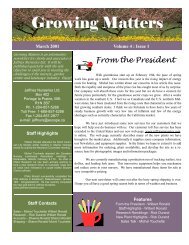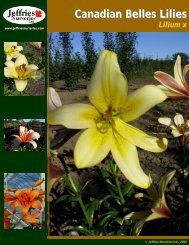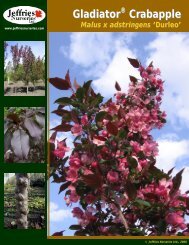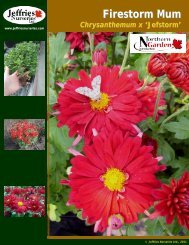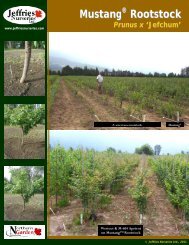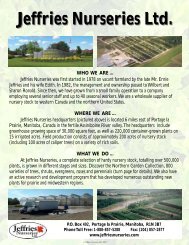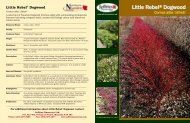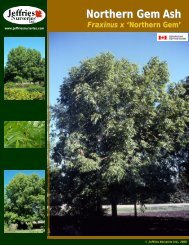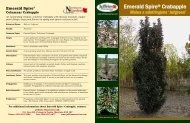Growing Matters
October 2003, Volume 6 - Issue 3 - Jeffries Nurseries Ltd.
October 2003, Volume 6 - Issue 3 - Jeffries Nurseries Ltd.
Create successful ePaper yourself
Turn your PDF publications into a flip-book with our unique Google optimized e-Paper software.
<strong>Growing</strong> <strong>Matters</strong><br />
Harvest Gold Linden<br />
<strong>Growing</strong> <strong>Matters</strong> is an informative<br />
newsletter for clients and associates of<br />
Jeffries Nurseries Ltd. It is published<br />
quarterly with the sole objective of assisting<br />
you in meeting the challenges of the<br />
nursery, garden centre and landscape industry.<br />
Enjoy!<br />
Jeffries Nurseries Ltd.<br />
Box 402<br />
Portage la Prairie, MB.<br />
R1N 3B7<br />
Toll Free: 1-888-857-5288<br />
Fax: (204) 857-2877<br />
e-mail: jeffnurs@escape.ca<br />
www.jeffriesnurseries.com<br />
E-mail Contacts<br />
President ….…….….. wilbert.ronald@jeffriesnurseries.com<br />
Shipping ……………... sharon.ronald@jeffriesnurseries.com<br />
Accounts ……………. shawna.ronald@jeffriesnurseries.com<br />
Marketing …………….. philip.ronald@jeffriesnurseries.com<br />
Sales ……………….… michel.touchette@jeffriesnurseries.com<br />
Research ……………...... rick.durand@jeffriesnurseries.com<br />
October 2003 Volume 6 : Issue 3<br />
What’s New<br />
Jeffries Nurseries Ltd. is<br />
pleased to welcome Rachel<br />
Giesbrecht to our office staff.<br />
Rachel shares an office with<br />
Shawna and will assist with<br />
order entry, accounts and<br />
customer relations.<br />
Tradeshows<br />
Prairie East - Winnipeg, MB.<br />
November 5 th & 6 th<br />
Saskatchewan - Saskatoon, SK.<br />
November 8 th & 9 th<br />
Prairie West - Edmonton, AB.<br />
November 13 th & 14 th<br />
North Dakota - Fargo, ND.<br />
January 25 th , 26 th & 27 th<br />
From the President<br />
As I write this article we are approaching our very<br />
busy fall digging and overwintering campaigns. Recent rainfall<br />
accumulations of 100 mm have restored our moisture<br />
after a long dry period in July and August. During the dry<br />
spell we appreciated our expanded reservoir and pumping<br />
capacity to keep our containers moist.<br />
Our 2003-2004 catalogue should now be in your<br />
hands. We appreciate your orders that are coming in and are<br />
making preliminary confirmation that will be followed with<br />
final numbers once grading is complete. We have added a<br />
new staff member to assist in office tasks and customer service.<br />
Rachel has some nursery background and is learning<br />
our specific nursery inventory and computer equipment.<br />
Over the past few weeks Mike has visited many of<br />
you and these calls are continuing, Mike’s experience and<br />
expertise are valued assets as he reviews any plant and<br />
growing problems you may be having. We will look forward<br />
to seeing many of you at the upcoming prairie tradeshows.<br />
This fall has been marked by strong landscape activity<br />
which is certainly encouraging in our business. We will<br />
continue to work hard to supply your required plant materials<br />
of all types. Several plant introductions are also coming<br />
along which will provide the prairie nursery with new stock<br />
for colder zones.<br />
Wilbert G. Ronald<br />
Jeffries Nurseries Tree Day<br />
September 5 th , 2003<br />
Ohio<br />
Buckeye
Fall Clean up<br />
Autumn is a time of maturity and rebuilding. Fall clean up is a ritual<br />
that makes the landscape less cluttered and helps reduce unwanted<br />
pests.<br />
Kill Disease<br />
The majority of leaves and grass clippings collected can be thrown<br />
on the compost pile. However, diseased leaves such as tar spot on<br />
maples, silver leaf on fruit trees and black spot on roses, should be<br />
either disposed of and burnt or sent to a municipal dumping site. If<br />
left behind or put in a compost heap that doesn't reach 70ºC to kill<br />
the disease, the rotting leaves will provide a source for the disease<br />
to spread. To control apple maggot, dropped apples should be disposed<br />
of at the dump.<br />
Mulch and Cover<br />
Last winter we experienced a tremendous amount of root injury because<br />
of the lack of snow. Mulching and covering of roses and tender<br />
perennials needs to take place at the end of October or when the<br />
temperature goes below minus 10ºC. Use flax straw and uninfected<br />
leaves from the local trees to completely cover the plants. A good<br />
thick layer of tree bark mulch is recommended to be placed around<br />
collector trees such as Autumn Blaze Maple and Prairie Silk Honeylocust<br />
to protect the roots, especially when there if no snow. Allowing<br />
turf grass to grow close to the tree bole is recommended for the<br />
collector trees so that the trees will shut down early and harden off<br />
quicker.<br />
Protect from Munchers<br />
Don't forget plastic tree wraps for all the fruit trees that mice and<br />
rabbits love to eat. These wraps should start at ground level and end<br />
at least 1 foot above the average snow level. Two or three wraps<br />
may be required, depending on the diameter of the tree. We install<br />
plastic tree wraps where the migrating sapsuckers start pecking their<br />
series of holes in the bark. The wraps tend to discourage them from<br />
pecking and can be taken down once winter arrives.<br />
Protect from Wind<br />
On the prairies, burlap wrapping of cedars is a common practice, yet<br />
this is not recommended. It is best to provide wind protection with<br />
burlap similar to a political campaign sign rather than wrapping the<br />
tree like a mummy. The burlap sign should protect the tree from the<br />
prevailing winds and/or direct sun exposure and be far enough away<br />
to allow air circulation around the tree. The tighter the mummy, the<br />
more likelihood the tree will superheat and dry out. R.D.<br />
Mikes Summer Review<br />
This summer I traveled the Prairie Provinces visiting different<br />
garden centers. Since I wear the hat of grower for a great deal<br />
of the season I admire garden centers when it comes to the challenge<br />
of watering plants. The vast majority of garden centers are<br />
individually watering their plants. However, the many types of pots,<br />
plants and soil media makes this task extremely challenging.<br />
Growers in B.C. tend to have media that drains very well<br />
due to their high rain fall and high relative humidity while prairie<br />
growers favor a media with good water holding capacity due their<br />
low relative humidity. An Ivory Silk Tree Lilac or Linden grown in<br />
a prairie media but watered at the same frequency as the same tree<br />
grown in BC media is a recipe for a disaster.<br />
I suggest placing a round 5 cm color plastic disc on the top<br />
of the media. Lets say green represents prairie media and white represent<br />
B.C. media. Then the manager on a particular day could instruct<br />
his staff today is a “white day” meaning only B.C. trees<br />
would get water. This suggestion would not be appropriate for container<br />
shrubs but keep on reading this newsletter and I may come up<br />
with a solution in future issues. If you have a creative solution for<br />
watering plants in the garden center that you would like to share<br />
please write me a note.<br />
M.T.<br />
Nursery Information on the Web<br />
For those of you who are “connected” the World Wide<br />
Web provides an ever-growing collection of practical information<br />
for nurseries and garden centers. I have put together a short list of<br />
some of the best websites for useful information and photographs.<br />
University of Connecticut Plant Database<br />
http://www.hort.uconn.edu/plants/a/a.html<br />
North Carolina State University Nursery Crop Science Website<br />
http://www.ces.ncsu.edu/depts/hort/nursery/<br />
Canada Hardiness Zone Map<br />
http://sis.agr.gc.ca/cansis/nsdb/climate/hardiness/ph2000webmap.html<br />
US Hardiness Zone Map<br />
http://www.usna.usda.gov/Hardzone/<br />
Canadian Nursery & Landscape Association<br />
http://www.canadanursery.com/canadanursery/index.lasso<br />
P.R.<br />
Research Highlights<br />
• In 2004/2005, look for a hardier upright<br />
cedar named ‘Sky Bound’ and an outstanding<br />
new apple named ‘Gemini’.<br />
Both will be available through Jeffries<br />
Nurseries Ltd.<br />
• We have recently selected some hardy<br />
chrysanthemums and coral bells. These<br />
new chrysanthemums will expand the<br />
colour range while the corals bells will<br />
be at least a zone hardier than the existing<br />
variegated and purple cultivars<br />
presently on the market. It is expected<br />
that these new perennial varieties will<br />
be available in two or three years.<br />
Sky Bound<br />
Cedar<br />
Gemini<br />
Apple<br />
Research<br />
Chrysanthemum<br />
Research<br />
Coral Bells



